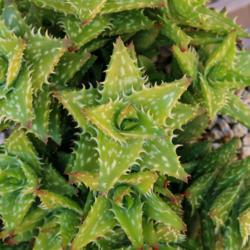Aloe vera (formerly known as barbadensis) is a yellow-flowered plant with mostly unspotted adult leaves. Its medicinal application involves topical use of the gel for skin-related ailments. The flowers (always yellow) are ventricose, meaning they have a little belly on the underside, a distinguishing feature. Aloe vera does not produce viable seeds, another distinguishing feature, and thus can only be grown true from offsets.

Small, clumping East African highland aloe with short, bumpy, triangular leaves. Very common and prolific in cultivation. Does okay in full sun but better with a little protection. Does not tolerate extreme heat. Has been used for hybrids. Often confused with Aloe squarrosa, a different, much less common plant which can be distinguished by its recurved leaves. Both of these plants are sometimes called Aloe zanzibarica in the trade, but that is an obsolete name specific for squarrosa (only). Neither is from Zanzibar. Details here.

The Climbing Aloe is native to South Africa and is said to be the fastest growing of all Aloes. It can reach 8 to 12 feet in height and needs the support of another plant or a trellis for climbing. If no support is available, the plant will attain a scraggly growth habit as my little plant seems to be doing, and if the stem touches the ground, it will take root in the soil. The Climbing Aloe prefers full sun, and like most succulents is drought tolerant.

Small, usually suckering aloe from South Africa and Lesotho with green leaves that taper to a dry terminal bristle. Dotted with white tubercles. Looks like a Haworthia. Often found at high altitudes, and unusually cold tolerant for an aloe. The rosette has a very different form depending on exposure, from open (50% shade) to clenched shut (full sun).

Small bumpy aloe hybrid with colorful green and red leaves. A very popular container plant in cultivation. Mass produced in tissue culture, in addition to pretty steady propagation from offsets and bulbils.

Solitary or usually suckering spotted aloe from South Africa with a 3-7 branched inflorescence. Widespread and variable in habitat and cultivation. Leaves reach up to 12 inches long in the landscape and are relatively wide. Lower surfaces of leaves have fewer or no spots. Flowers may be pink, orange, yellow or red, and are constricted above the base, with barely exserted stamens. Racemes are densely flowered, flat-topped, and capitate.

Deceptively large, tough, multistemmed aloe with outstanding torch-like flowers in late fall to winter. Very easy to propagate: stick a cutting in the ground, water every 2 weeks, and voila, flowers next season. Will turn funky colors when stressed, often a striking purple while rooting or during drought stress. Requires lots of space or lots of pruning to do well, though it does tolerate confined spaces (still, be prepared to prune). Tends to dominate hybrids, in both habit and flowers.

High-altitude aloe from western Lesotho with a distinct spiraling form. Highly desired and usually short-lived in cultivation. Solitary. Flowers are salmon-pink to red, rarely yellow, on branched inflorescences.

I have 2 plants of this smaller variety of aloe. Both arrived about 4 years ago as 2" pups in a trade. One has stayed under 5" in a stemmed glass and the other has grown to 7" in a terracotta 8" pot in filtered sun on my SE exposure porch. I cover them with a washcloth when temps drop to 34 degrees and a frost is possible. If temps dip to 32, I bring them into my garage for a few days then back out on my porch where they are protected from north wind. Neither has sent out pups yet, but I hope they multiply.

Small, tough, drought-resistant aloe from South Africa and Namibia with distinctive patterned green leaves that are V-shaped in cross section. Spineless. Flowers are red, rarely yellow. May be solitary or clumping.
